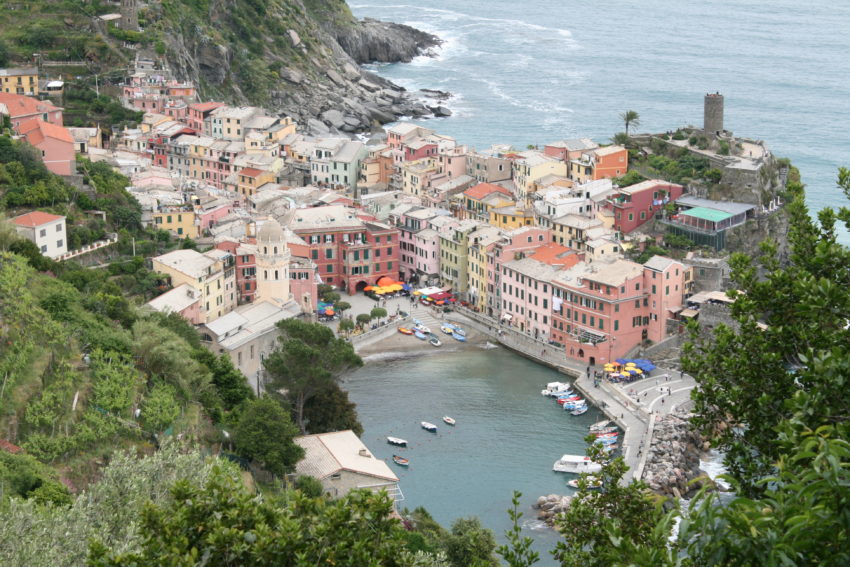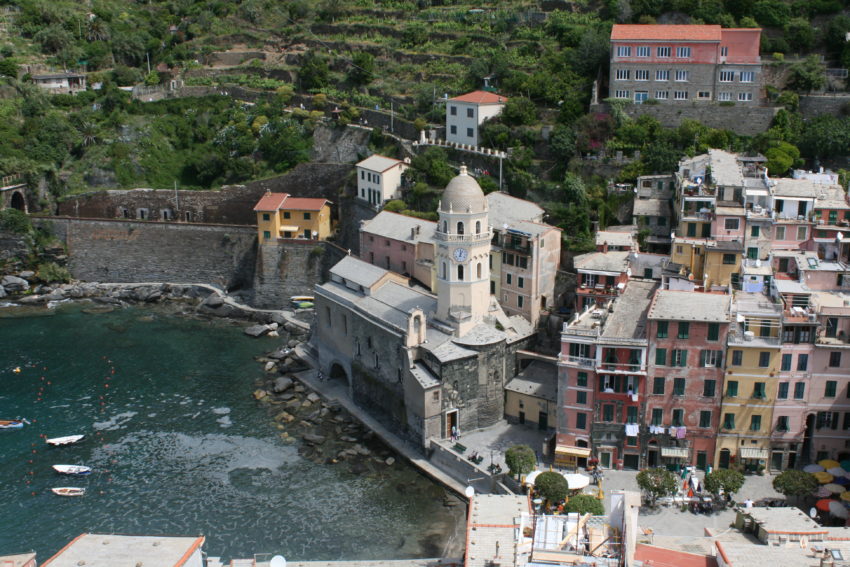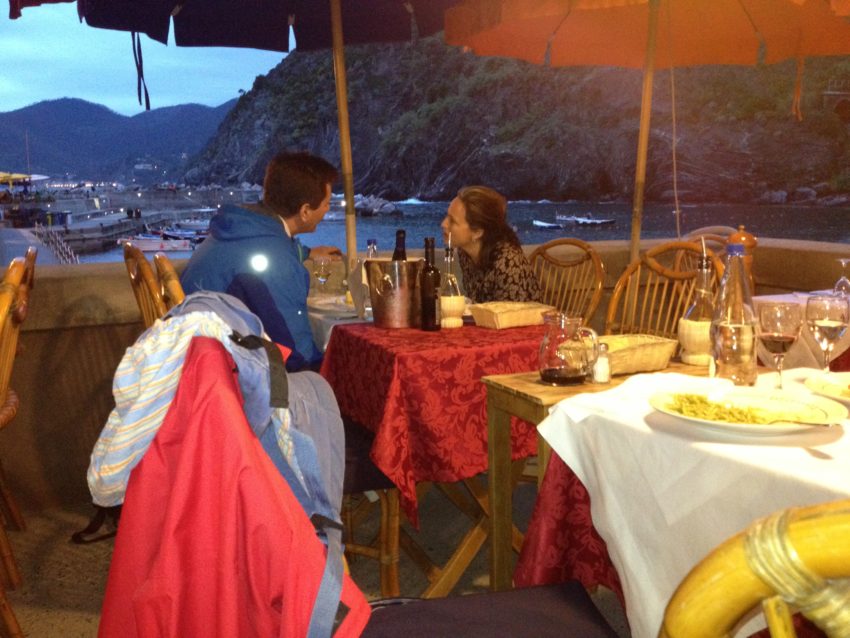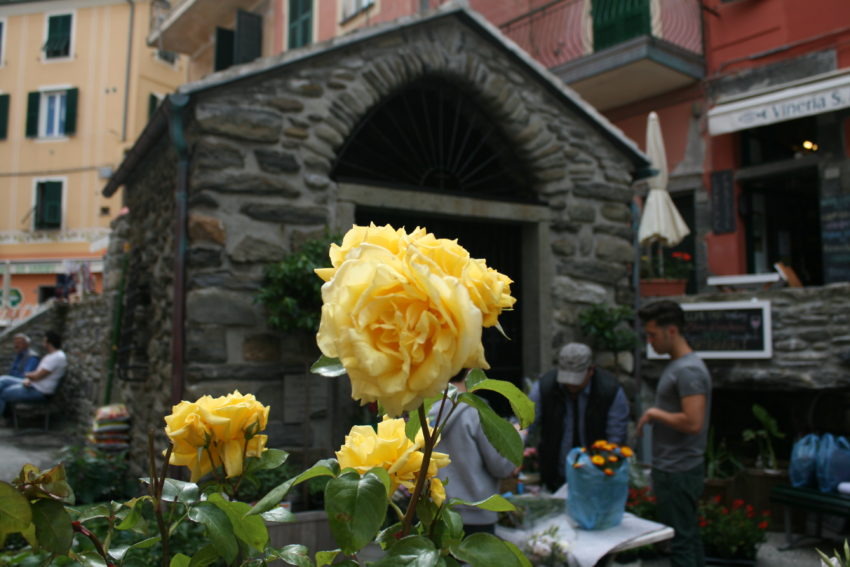Retired in Rome Journal: After the ‘slide, Vernazza returns as the shining star of Cinque Terre






MAY 20
VERNAZZA, Italy — The chunky middle-aged American woman, her face beaded with sweat, turned around in front of me. She headed down the steep stone steps back toward Monterosso.
“Well, we saw what we don’t want to do,” she said as her party trailed behind her.
I had a misconception about hiking the Cinque Terre. It’s short for a world-renowned hike. It’s comically short. It’s seven miles. That’s it. Most people take five days to do it, spending a night in each of the five fishing villages. That’s about a mile and a half a day. Last month I hiked 8 1/2 miles to Monte Torrecane in eastern Lazio in about 7 1/2 hours. I hike a mile and a half up my 90 steps to my apartment in Rome every day.
But the path from Monterosso to Vernazza is steep. In patches it appears straight up. I passed numerous people who, like the unfit Yank, weren’t about to challenge themselves much past vantage points to take pictures looking back at Monterosso.
At least they have their priorities right. On Cinque Terre, a camera is more important than good hiking shoes. With every turn, the towering cliffs offer a new angle of a gorgeous scene you left behind. Leaving Monterosso, I walked up a steep path and along the coastline where looking back I saw a view of Monterosso I could only see otherwise on an airplane. It was a cluster of small buildings huddled around a quaint port with the cliffs guarding it like a giant locked door. The overcast skies didn’t diminish the sheer beauty of Monterosso’s isolation. From this distance it looked no bigger than a hamlet and yet it’s the biggest town of the five, a good omen for the next few days.
The protective nature of these cliffside coves is exactly how these five villages began. Monterosso dates back to 643 AD when Ligurian hill people moved down to the coast to escape barbarians. Riomaggiore, the farthest south of the five, was established in the 8th century by Greeks escaping invaders from Byzantine.
Today, it’s being invaded by Americans, Brits, Germans, Swiss, Scandinavians, Japanese and anyone else wielding a backpack, hiking poles and a tacky T-shirt. Walking the Cinque Terre I heard a mishmash of American English, British English, Australian English, German, French, Japanese and the full range of Scandinavian linguistics.
The shapes and sizes were as varied as the nationalities: muscular Aussies racing past me like they were looking for a bathroom. Fat daytrippers carrying nothing but a water bottle and a belly. Curvy coeds in short shorts and well-worn backpacks. Middle-aged Europeans with flat stomachs and gray hair. Cinque Terre’s brief length lures many to its trailhead but its steepness makes many wonder if walking along the beach was a better idea.
Such as the Japanese couple I passed. The guy was wearing a yellow dress shirt and long pants. He carried not only a backpack but two jet-black, steel suitcases, one of which his lady companion could barely lift. He looked very fit but watching him lug two bulky boxes up a staircase with about a 45-degree grade, his yellow shirt darkened by sweat, made even me tired. A rock-hard American woman in her 20s warned him, “You have a lot of steps to go. This takes about two hours. For you, it’ll take three. I suggest you take the train.”
They continued, trudging on ahead of me with more jump stops than an NBA point guard. When I came across them, he was sitting on a stone wall, wiping the sweat off his forehead. They weren’t looking at the spectacular view of Monterosso behind us.
“We take train,” he said with an air of defeat.
A little while later, an elderly Brit trudged ever so slowly up the hill, his pasty wife in tow. Someone mentioned he was walking awfully slow and asked if he was going to turn back. He flashed his eyes behind him to his wife and said, in perfectly subtle British humor, “I have a passenger.”
His wife, in not so subtle British humor, huffed, “Get stuffed.”
I had a similar feeling when we reached the ticket booth a few hundred meters past them. A short line had formed and it was buzzing. News was circulating. A 2011 landslide that killed nine had left the path from Vernazza south unpassable. The storm’s devastation even reached Denver. I remember reading how the bodies of three Vernazza men were later found in St. Tropez, France. Alberto Monaci, Liguria’s president, called it a “meteorological explosion.” Monterosso was wiped out. Videos showed a wall of mud pouring down Vernazza’s main drag of Via Roma into the harbor, where motor boats were thrown around like toys in a bathtub.
This would be my only hike of the trip. I recall Roman friends telling me the landslide had put roadblocks on most of Cinque Terre but I also remember reading that it was expected to be cleared up by early 2014. It’s not close.
Then again, this is Italy. This is the same country that didn’t give a dime to the city of L’Aquila after the 2009 earthquake killed 308 and displaced 65,000. If I’m ever in a natural disaster, remind me never to have one in Italy. However, to Italy’s credit, it had Vernazza up and greeting tourists again by the fall of 2012.
For someone who hikes 90 steps every time he walks through his front door, I didn’t find the hike very difficult. It’s easy to hike uphill — even straight uphill — when you stop every 10 minutes to take tons of pictures. The Gulf of Genoa isn’t all that stunning. On a gray day, the blue water turns darker blue as if you’re looking at it at night. But with the backdrop of a coastline as curvy as an Italian showgirl and with the sheer rock cliffs stretching to the heavens, the hike is like walking through some artist’s living painting.
The trail itself dates back to the 12th century when Italy wasn’t a republic but a series of city-states, one hating another more than the next. The Republic of Genoa used this trail to get from village to village all the way until 1874 when the railway that is still used burrowed into the cliffs.
The Monterosso-Vernazza leg goes basically straight up and straight down. I stopped at a perfectly placed picnic table to munch on some two-day-old cherries that weren’t nearly as good after being crunched in the top of my backpack. A middle-aged couple from Tennessee sat next to me for a snack and conversation. This is the first two-week vacation in years. He was a professor at East Tennessee State then opened his own business. It was quite successful, so successful he couldn’t leave it until this year. They made the usual path from Venice to Florence to Cinque Terre but went to the charming Umbrian town of Ascoli Piceno to see the wife’s good friend. That’s where they saw the true Italy.
I know. When I lived here the first time, I put a giant map of Italy on the wall. I threw a felt pen at it and went to whatever towns it hit. Either I lucked out or I’m very good at darts. The town I hit was Ascoli Piceno, a mid-sized Umbrian town of 50,000 with one of Italy’s perfect piazzas and hardly any English spoken. Now, me and the Tennessee couple found ourselves high above the Gulf of Genoa with tourists passing us like we were at a freeway rest stop. One even took our picture.
“Ah, the perfect picnic spot,” she said in an English accent, barely stopping long enough to eat a cherry.
Once we hit the downhill stretch, it wasn’t long before, in the distance, we saw Vernazza. Of the five Cinque Terre villages, Vernazza is the most quaint. It is a series of three and four-story brightly colored buildings surrounding a tiny harbor about the size of an Olympic-sized swimming complex. From high above on a cliff, it looks like a pond in the middle of a kid’s Erector set.
Full disclosure: I’d been here before. In about 2009, I came here after eating my way through Parma, the best food town in Italy. It was February and cold. Parma had a spattering of snow on the ground. A torrential downpour greeted me as I emerged from Nervazza’s tiny train station. Everything was closed. I had to throw a pebble at an old woman’s window to let me into her pensione across the harbor. I was about the only tourist. I went to a tiny sliver of a bar and drank local wine and talked to the locals, all trying to get by through the lean winter before the tourists arrived.
This time, I was back, along with a few thousand of my fellow tourists. The harbor was jumping. Tourist shops selling “I (heart) Cinque Terre” T-shirts and limoncello in souvenir bottles the shapes of lemons. I didn’t care. The day trippers were all leaving when I went back to the bar that still held court on the harbor. The Burgus Bar served a cheap local white wine called a Colli Luni Polenza, made from a grape grown only between Vernazza and Corniglia, the next village down. I also tried a hugely popular Italian summer drink. A spritz is made up of prosecco, sparkling mineral water and a vile, bitter liqueur called Aperol. It looks like Orange Aid and frighteningly like Campari, the traditional Italian drink emblazoned on umbrellas from Sicily to Miami. It looks like Kool-Aid and tastes like boat fuel. A spritz has a touch of sweetness to it but not enough to say you did much more than tried it, kind of like tripe or live beetle larvae.
I ate at a lovely outdoor restaurant called Gambero Rosso (the Red Prawn) where I continued my tour through the anchovy cookbook. I had Tegame di Vernazza, a big mishmash of anchovies, boiled potatoes in tomato sauce. It was just salted enough to give it some flavor and with the soft Ligurian bread it made for the perfect restoration of calories after a three-hour hike.
However, it was nothing compared to the scenery. Little motor boats bobbed up and down in the water not far from a whole row docked on the harbor. The sun was setting, and the harbor lights splashed off the water. The lights of Monterosso began to shine off in the distance. Wash hung from an apartment window overhead.
My hiking ends here. That’s OK. This was the hike of a lifetime.


June 10, 2014 @ 12:31 pm
Jeff and I stayed in Vernazza twice over the years. We had such a good time hiking between the towns. I love your blog … of course, I’m very envious of your lifestyle. — Jenny